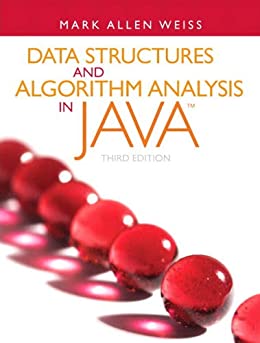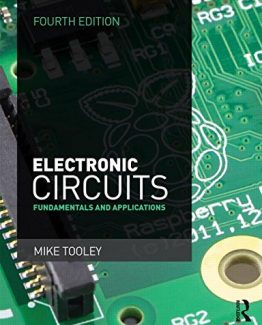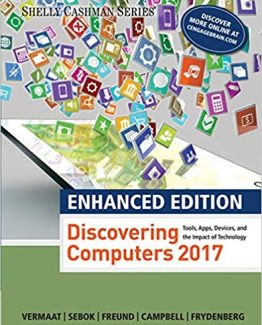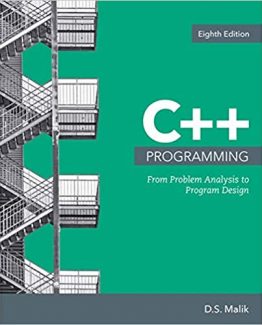Data Structures and Algorithm Analysis in Java 3rd Edition by Mark Weiss, ISBN-13: 978-0132576277
[PDF eBook eTextbook]
- Publisher: Pearson; 3rd edition (November 18, 2011)
- Language: English
- 648 pages
- ISBN-10: 0132576279
- ISBN-13: 978-0132576277
Data Structures and Algorithm Analysis in Java is an “advanced algorithms” book that fits between traditional CS2 and Algorithms Analysis courses. In the old ACM Curriculum Guidelines, this course was known as CS7. This text is for readers who want to learn good programming and algorithm analysis skills simultaneously so that they can develop such programs with the maximum amount of efficiency. Readers should have some knowledge of intermediate programming, including topics as object-based programming and recursion, and some background in discrete math.
As the speed and power of computers increases, so does the need for effective programming and algorithm analysis. By approaching these skills in tandem, Mark Allen Weiss teaches readers to develop well-constructed, maximally efficient programs in Java.
Weiss clearly explains topics from binary heaps to sorting to NP-completeness, and dedicates a full chapter to amortized analysis and advanced data structures and their implementation. Figures and examples illustrating successive stages of algorithms contribute to Weiss’ careful, rigorous and in-depth analysis of each type of algorithm. A logical organization of topics and full access to source code complement the text’s coverage.
Table of Contents:
Title Page
Copyright Page
Contents
Preface
Acknowledgments
Chapter 1 Introduction
1.1 What’s the Book About?
1.2 Mathematics Review
1.2.1 Exponents
1.2.2 Logarithms
1.2.3 Series
1.2.4 Modular Arithmetic
1.2.5 The P Word
1.3 A Brief Introduction to Recursion
1.4 Implementing Generic Components Pre-Java 5
1.4.1 Using Object for Genericity
1.4.2 Wrappers for Primitive Types
1.4.3 Using Interface Types for Genericity
1.4.4 Compatibility of Array Types
1.5 Implementing Generic Components Using Java 5 Generics
1.5.1 Simple Generic Classes and Interfaces
1.5.2 Autoboxing/Unboxing
1.5.3 The Diamond Operator
1.5.4 Wildcards with Bounds
1.5.5 Generic Static Methods
1.5.6 Type Bounds
1.5.7 Type Erasure
1.5.8 Restrictions on Generics
1.6 Function Objects
Summary
Exercises
References
Chapter 2 Algorithm Analysis
2.1 Mathematical Background
2.2 Model
2.3 What to Analyze
2.4 Running Time Calculations
2.4.1 A Simple Example
2.4.2 General Rules
2.4.3 Solutions for the Maximum Subsequence Sum Problem
2.4.4 Logarithms in the Running Time
2.4.5 A Grain of Salt
Summary
Exercises
References
Chapter 3 Lists, Stacks, and Queues
3.1 Abstract Data Types (ADTs)
3.2 The List ADT
3.2.1 Simple Array Implementation of Lists
3.2.2 Simple Linked Lists
3.3 Lists in the Java Collections API
3.3.1 Collection Interface
3.3.2 Iterators
3.3.3 The List Interface, ArrayList, and LinkedList
3.3.4 Example: Using remove on a LinkedList
3.3.5 ListIterators
3.4 Implementation of ArrayList
3.4.1 The Basic Class
3.4.2 The Iterator and Java Nested and Inner Classes
3.5 Implementation of LinkedList
3.6 The Stack ADT
3.6.1 Stack Model
3.6.2 Implementation of Stacks
3.6.3 Applications
3.7 The Queue ADT
3.7.1 Queue Model
3.7.2 Array Implementation of Queues
3.7.3 Applications of Queues
Summary
Exercises
Chapter 4 Trees
4.1 Preliminaries
4.1.1 Implementation of Trees
4.1.2 Tree Traversals with an Application
4.2 Binary Trees
4.2.1 Implementation
4.2.2 An Example: Expression Trees
4.3 The Search Tree ADT—Binary Search Trees
4.3.1 contains
4.3.2 findMin and findMax
4.3.3 insert
4.3.4 remove
4.3.5 Average-Case Analysis
4.4 AVL Trees
4.4.1 Single Rotation
4.4.2 Double Rotation
4.5 Splay Trees
4.5.1 A Simple Idea (That Does Not Work)
4.5.2 Splaying
4.6 Tree Traversals (Revisited)
4.7 B-Trees
4.8 Sets and Maps in the Standard Library
4.8.1 Sets
4.8.2 Maps
4.8.3 Implementation of TreeSet and TreeMap
4.8.4 An Example That Uses Several Maps
Summary
Exercises
References
Chapter 5 Hashing
5.1 General Idea
5.2 Hash Function
5.3 Separate Chaining
5.4 Hash Tables Without Linked Lists
5.4.1 Linear Probing
5.4.2 Quadratic Probing
5.4.3 Double Hashing
5.5 Rehashing
5.6 Hash Tables in the Standard Library
5.7 Hash Tables with Worst-Case O(1) Access
5.7.1 Perfect Hashing
5.7.2 Cuckoo Hashing
5.7.3 Hopscotch Hashing
5.8 Universal Hashing
5.9 Extendible Hashing
Summary
Exercises
References
Chapter 6 Priority Queues (Heaps)
6.1 Model
6.2 Simple Implementations
6.3 Binary Heap
6.3.1 Structure Property
6.3.2 Heap-Order Property
6.3.3 Basic Heap Operations
6.3.4 Other Heap Operations
6.4 Applications of Priority Queues
6.4.1 The Selection Problem
6.4.2 Event Simulation
6.5 d-Heaps
6.6 Leftist Heaps
6.6.1 Leftist Heap Property
6.6.2 Leftist Heap Operations
6.7 Skew Heaps
6.8 Binomial Queues
6.8.1 Binomial Queue Structure
6.8.2 Binomial Queue Operations
6.8.3 Implementation of Binomial Queues
6.9 Priority Queues in the Standard Library
Summary
Exercises
References
Chapter 7 Sorting
7.1 Preliminaries
7.2 Insertion Sort
7.2.1 The Algorithm
7.2.2 Analysis of Insertion Sort
7.3 A Lower Bound for Simple Sorting Algorithms
7.4 Shellsort
7.4.1 Worst-Case Analysis of Shellsort
7.5 Heapsort
7.5.1 Analysis of Heapsort
7.6 Mergesort
7.6.1 Analysis of Mergesort
7.7 Quicksort
7.7.1 Picking the Pivot
7.7.2 Partitioning Strategy
7.7.3 Small Arrays
7.7.4 Actual Quicksort Routines
7.7.5 Analysis of Quicksort
7.7.6 A Linear-Expected-Time Algorithm for Selection
7.8 A General Lower Bound for Sorting
7.8.1 Decision Trees
7.9 Decision-Tree Lower Bounds for Selection Problems
7.10 Adversary Lower Bounds
7.11 Linear-Time Sorts: Bucket Sort and Radix Sort
7.12 External Sorting
7.12.1 Why We Need New Algorithms
7.12.2 Model for External Sorting
7.12.3 The Simple Algorithm
7.12.4 Multiway Merge
7.12.5 Polyphase Merge
7.12.6 Replacement Selection
Summary
Exercises
References
Chapter 8 The Disjoint Set Class
8.1 Equivalence Relations
8.2 The Dynamic Equivalence Problem
8.3 Basic Data Structure
8.4 Smart Union Algorithms
8.5 Path Compression
8.6 Worst Case for Union-by-Rank and Path Compression
8.6.1 Slowly Growing Functions
8.6.2 An Analysis By Recursive Decomposition
8.6.3 An O( M log * N ) Bound
8.6.4 An O( M α(M, N) ) Bound
8.7 An Application
Summary
Exercises
References
Chapter 9 Graph Algorithms
9.1 Definitions
9.1.1 Representation of Graphs
9.2 Topological Sort
9.3 Shortest-Path Algorithms
9.3.1 Unweighted Shortest Paths
9.3.2 Dijkstra’s Algorithm
9.3.3 Graphs with Negative Edge Costs
9.3.4 Acyclic Graphs
9.3.5 All-Pairs Shortest Path
9.3.6 Shortest-Path Example
9.4 Network Flow Problems
9.4.1 A Simple Maximum-Flow Algorithm
9.5 Minimum Spanning Tree
9.5.1 Prim’s Algorithm
9.5.2 Kruskal’s Algorithm
9.6 Applications of Depth-First Search
9.6.1 Undirected Graphs
9.6.2 Biconnectivity
9.6.3 Euler Circuits
9.6.4 Directed Graphs
9.6.5 Finding Strong Components
9.7 Introduction to NP-Completeness
9.7.1 Easy vs. Hard
9.7.2 The Class NP
9.7.3 NP-Complete Problems
Summary
Exercises
References
Chapter 10 Algorithm Design Techniques
10.1 Greedy Algorithms
10.1.1 A Simple Scheduling Problem
10.1.2 Huffman Codes
10.1.3 Approximate Bin Packing
10.2 Divide and Conquer
10.2.1 Running Time of Divide-and-Conquer Algorithms
10.2.2 Closest-Points Problem
10.2.3 The Selection Problem
10.2.4 Theoretical Improvements for Arithmetic Problems
10.3 Dynamic Programming
10.3.1 Using a Table Instead of Recursion
10.3.2 Ordering Matrix Multiplications
10.3.3 Optimal Binary Search Tree
10.3.4 All-Pairs Shortest Path
10.4 Randomized Algorithms
10.4.1 Random Number Generators
10.4.2 Skip Lists
10.4.3 Primality Testing
10.5 Backtracking Algorithms
10.5.1 The Turnpike Reconstruction Problem
10.5.2 Games
Summary
Exercises
References
Chapter 11 Amortized Analysis
11.1 An Unrelated Puzzle
11.2 Binomial Queues
11.3 Skew Heaps
11.4 Fibonacci Heaps
11.4.1 Cutting Nodes in Leftist Heaps
11.4.2 Lazy Merging for Binomial Queues
11.4.3 The Fibonacci Heap Operations
11.4.4 Proof of the Time Bound
11.5 Splay Trees
Summary
Exercises
References
Chapter 12 Advanced Data Structures and Implementation
12.1 Top-Down Splay Trees
12.2 Red-Black Trees
12.2.1 Bottom-Up Insertion
12.2.2 Top-Down Red-Black Trees
12.2.3 Top-Down Deletion
12.3 Treaps
12.4 Suffix Arrays and Suffix Trees
12.4.1 Suffix Arrays
12.4.2 Suffix Trees
12.4.3 Linear-Time Construction of Suffix Arrays and Suffix Trees
12.5 k-d Trees
12.6 Pairing Heaps
Summary
Exercises
References
Index
Mark Allen Weiss is Professor and Associate Director for the School of Computing and Information Sciences at Florida International University. He is also currently serving as both Director of Undergraduate Studies and Director of Graduate Studies. He received his Bachelor’s Degree in Electrical Engineering from the Cooper Union in 1983, and his Ph.D. in Computer Science from Princeton University in 1987, working under Bob Sedgewick. He has been at FIU since 1987 and was promoted to Professor in 1996. His interests include data structures, algorithms, and education. He is most well-known for his highly-acclaimed Data Structures textbooks, which have been used for a generation by roughly a million students.
Professor Weiss is the author of numerous publications in top-rated journals and was recipient of the University’s Excellence in Research Award in 1994. In 1996 at FIU he was the first in the world to teach Data Structures using the Java programming language, which is now the de facto standard. From 1997-2004 he served as a member of the Advanced Placement Computer Science Development Committee, chairing the committee from 2000-2004. The committee designed the curriculum and wrote the AP exams that were taken by 20,000 high school students annually.
In addition to his Research Award in 1994, Professor Weiss is also the recipient of the University’s Excellence in Teaching Award in 1999 and the School of Computing and Information Science Excellence in Teaching Award (2005) and Excellence in Service Award (2007).
What makes us different?
• Instant Download
• Always Competitive Pricing
• 100% Privacy
• FREE Sample Available
• 24-7 LIVE Customer Support






Reviews
There are no reviews yet.